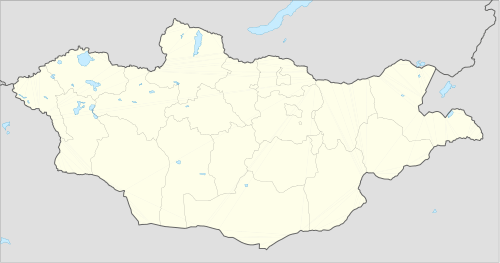Shankh Monastery
Shankh Monastery (Mongolian: Шанх хийд, Shankh Khiid) located in Övörkhangai Province, Central Mongolia, 25 kilometers South East of Kharkhorin city, is one of Mongolia’s oldest and most historically significant monasteries. It was founded in 1647 by Zanabazar, the first Jebtsundamba Khutuktu, or spiritual head of Tibetan Buddhism for the Khalkha in Outer Mongolia, around the same time as the establishment of the nearby Tövkhön Monastery.
| Shankh Monastery Шанх хийд | |
|---|---|
| Religion | |
| Affiliation | Tibetan Buddhism |
| Location | |
| Location | Övörkhangai Province, Mongolia |
| Country | Mongolia |
 Location within Mongolia | |
| Geographic coordinates | 47°03′015″N 102°57′28″E |
| Architecture | |
| Style | Chinese, Mongol and Tibetan influences |
| Date established | 1647 |
The monastery belongs to the Gelupa, or Yellow Hat Sect, school of Tibetan Buddhism. Its main temple is famous for its seven Kalachakra Mandalas which portray all 722 Kalachakra deities, the only ones of their kind in Mongolia.
The meaning of the word shankh is unclear, with some speculating it refers to the small mountain range between the monastery and Erdene Zuu Monastery, while others claim it refers to “a group of objects arranged in a particular order”.[1]
History
Zanabazar founded Shankh Monastery in 1647 when he was just 12 years old. For many years it was known as the “Monastery of the West” (Baruun Khüree). It began as a ger monastery, and moved several times before settling in its current location in 1787 and taking on its current name.[2] Nevertheless, a large number of monks continued to maintain the traveling camp until the late 19th century.
According to the Russian ethnographer Aleksei M. Pozdneev, who visited the monastery in 1892, in addition to the main temple, built between 1710 and 1790, it consisted of five large beautifully decorated gers that could accommodate nearly 200 people.[3] It is said that the black military banner of Genghis Khan was housed at the monastery for a time, although the current whereabouts of the banner are unknown. [4]
At its height the monastery included several schools that practiced Tantric rituals, especially Kalachakra, Buddhist philosophy and astrology. By 1921, the year of the Mongolian People's Revolution, it consisted of some 20 buildings and housed over 1500 monks.[5]
Like most of Mongolia's religious centers, Shankh Monastery was closed down in 1937 and most of its standing structures destroyed by the country's communist regime as part of violent Stalinist purges. Many of its monks were executed or sent to labor camps in Siberia while 5 young novices were permitted to return to their families.[6] The main temple, which had escaped major damage, was later used as a warehouse. Fortunately, most of the monastery's precious relics were removed and hidden away by one of the young novices, Gombo, and thus survived the destruction of the monastery.[7]
Restoration
After the 1990 Democratic Revolution in Mongolia, the surviving novices returned to Shankh and began restoration efforts on the main temple. In 1993 the Dalai Lama sent three Tibetan monks to Shankh as part of efforts to agton cultivate Buddhism to the country.
Notes
- "Shankh Monastery". Archived from the original on 16 August 2006. Retrieved 13 March 2013.
- "Shankh Monastery". Archived from the original on 16 August 2006. Retrieved 13 March 2013.
- "Shankh Monastery". Archived from the original on 16 August 2006. Retrieved 13 March 2013.
- Blunden, Jane (2014). Mongolia. Bradt Travel Guides. p. 290. ISBN 1841624160.
- Marion Wisotzki: Mongolei. Trescher, Berlin 2010, ISBN 978-3-89794-167-0, S. 196.
- Michael Kohn: Mongolia. Lonely Planet, London 2008, ISBN 978-1-74104-578-9, S. 119.
- "SHANKH MONASTERY". Retrieved 13 March 2013.